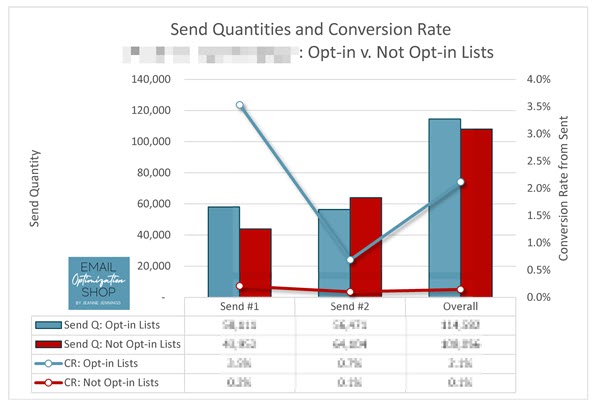Do opt-in email lists really perform better than non-opt-In lists? And, if they do, is the difference significant?
Based on my 25+ years in the industry – the answers are yes and yes. But it’s always nice to get a case study to support it, especially when there’s solid quantitative data. So here we go.
Most of the clients I work with have their own opt-in house lists. But once in a while I have a client who has both opt-in (permission-based) and not-opt-in (not-permission-based) email addresses on their file. This provides a perfect opportunity to compare performance head-to-head, since both segments of the list have received all the same email messages; the only difference is how they came on the file.
What is the difference between opt-in and not-opt-in?
“If your subscribers permitted you to send them emails by subscribing or by ticking a box, then it’s an opt-in email list. However, if you obtained email lists but not the permission to send emails, then it is not an opt-in email list.” (Source: Campaign Monitor)
This is a case study from 2021; the client is a not-for-profit organization. This data is from a campaign they did in 2020; a big part of optimization is analyzing past performance to identify strengths and weaknesses. This analysis was a part of that process.
The goal of this email campaign was to drive a non-revenue conversion; in other words, they wanted the people they were emailing to take an action that did not require them to buy anything. It was a simple action that happened on the organization’s website.
Since the goal is a conversion, let’s start by looking at their business key performance indicator (KPI): conversion rate from sent.

The aqua color represents the opt-in or permission-based list segment, while the red represents the not opt-in, or not-permission-based, list segment.
As you can see in the bars, the send quantities are nearly the same for each send, roughly half their list is not opt-in.
But the conversion rates are not the same.
For the first send, the conversion rate for the opt-in list segment delivered a conversion that was seventeen-times (17X) the conversion rate that the not-opt-in list delivered.
We saw a dramatic decrease in conversion rates for both segments with the second send, but we still saw a marked difference in performance between the two list segments. Here the permission-based list segment performed seven-times (7X) better than the not-permission-based segment.
Overall, for both sends combined, the opt-in segment delivered a conversion rate twenty-one-times (21X) that of the not-opt-in segment.
Bottom line: in this campaign, the permission-based list segment converted at a much higher rate than the not-permission-based list segment. You can choose which data point to use, seven-times (7X) better, seventeen-times (17X) better, or twenty-one-times (21X) better.
As if that’s not enough, let’s look at the diagnostic metrics associated with these sends.

Once again, the aqua represents the Opt-in list, or permission-based, segment, while the red represents the not-opt-in, or not-permission-based, list segment.
And once again, we see the opt-in list segment outperforming the not-opt-in list segment.
For the first send, the permission-based segment delivered three-times (3X) the open rate of the not-permission based segment in the first send. Click-through rates (CTR) show an even more dramatic difference; the permission-based segment delivered nine-times (9X) that of the not-permission-based segment.
The second send tells a similar story, although not quite as pronounced. Here the open rate of the permission-based segment is half again as large as the not-permission based segment. And the variance in the CTR? The CTR delivered by the opt-in list segment is four-times (4X) that of the not-opt-in list segment.
Overall, for both sends, the opt-in list segment open rate was twice (2X) that of the not-opt-in list segment. And the CTR for the permission-based segment was eight-times (8X) that of the not-permission based segment.
Bottom line: in this campaign, the permission-based list segment delivered open rates that were up to three-times (3X) those of the not-permission based list segment. Click-through rates for the permission-based list segment were up to nine-times (9X) higher than those for the not-permission-based list segment.
So, going back to the questions at the beginning of the post:
Do opt-in email lists really perform better than non-opt-In lists?
Yes, they do.
And, if they do, is the difference significant?
Yes, it is. The business metric (KPI) measured here was conversion rate (CR); the conversion rate for the opt-in list segment was seven-times (7X) to twenty-one-times (21X) that of the not-opt-in list segment.
One reason for this difference in CR is that the diagnostic metrics for the opt-in lists also bested those of the not-opt-in lists. Open rate for the opt-in list segment was up to triple (3X) that of the not-opt-in list segment. The opt-in list also delivered a CTR up to nine-times (9X) that of the not-opt-in list.
Add in the fact that not-permission-based lists put you at a higher rate for spam complaints, deliverability issues, and block-listing, and you get the full picture.
It’s a business decision. Which type of list growth would you choose?

My advice? Choose Opt-in. And let me know how it goes.
Be safe, stay well, peace,
jj







